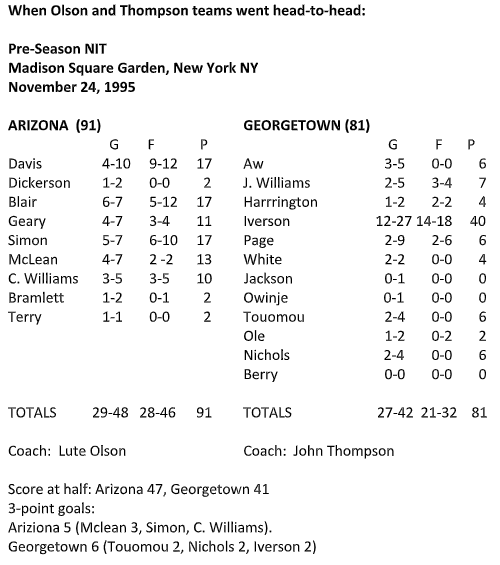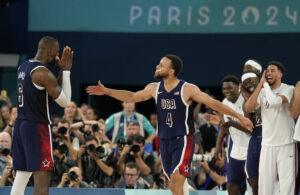- Attacking style not the only reason some Tottenham fans will back Ange Postecoglou until the bitter endPosted 5 months ago
- Paris Olympics takeaways: What did Team USA’s crunch-time lineup say about NBA’s hierarchy?Posted 10 months ago
- Zach Edey posted an easy double-double in Summer League debut. Here’s why he’ll succeed in NBAPosted 12 months ago
- What will we most remember these champion Boston Celtics for?Posted 12 months ago
- After long, seven-year road filled with excruciating losses, Celtics’ coast to NBA title felt ‘surreal’Posted 12 months ago
- South Florida men’s basketball is on an unbelievable heater– but also still on the bubblePosted 1 year ago
- Kobe Bufkin is balling out for Atlanta Hawks’ G League team. When will he be called up to NBA?Posted 1 year ago
- Former Knicks guards Immanuel Quickley, RJ Barrett may yet prove Raptors won the OG Anunoby tradePosted 1 year ago
- Rebounding savant Oscar Tshiebwe finally gets NBA chance he’s deserved for yearsPosted 2 years ago
- Is Tyrese Maxey vs. Tyrese Haliburton the next great NBA guard rivalry?Posted 2 years ago
Hall of Fame coaches Lute Olson and John Thompson died recently in the span of just three days, leaving a big void in college basketball
- Updated: September 4, 2020
By Joel Alderman
Their careers overlapped 17 seasons, but Lute Olson and John Thompson, who were Hall of Fame college basketball coaches, had a strange but sad commonality. They recently both died at almost the same time, Olson on Aug 27 and Thompson three days later on Aug 30. Olson was 85 and Thompson 78.
Instead of paying tribute to these two icons of the coaching fraternity in separate articles, I thought it would be fitting to combine their heritages, and in the process research whether they ever opposed each other on the bench
Sure enough their teams did play such a game. It was in the finals of the 1995 pre-season NIT when Thompson’s Hoyas wiped out a 17-point deficit only to lose the game and the tournament championship. More on that contest will follow.
Olson was hospitalized last year after suffering a stroke, and was recently moved into hospice care. He died as one of only five Division I coaches with at least 20 consecutive 20-win seasons.
Olson at Arizona (1983-2007)
Olson went 589-187 in 24 seasons at Arizona and guided the Wildcats to four Final Four appearances, 23 consecutive NCAA tournaments and 11 Pac-10 titles, as well as the national title in 1997. Including his eight years at Iowa and Long Beach State, he was 776-285.
He was inducted into the Naismith Memorial Basketball Hall of Fame in 2002 and the College Basketball Hall of Fame in 2006. A statute of Olson was placed outside the McKale Memorial Center in Tucson in 2018. The Wildcats’ home court inside is named the “Lute and Bobbi Olson Court” to honor him and his first wife, who died 19-1/2 years ago.
Golden State Warriors coach Steve Kerr, who played under Olson at Arizona from 1983 to 1988, tweeted:
“It’s hard to put into words how much Lute Olson meant to me. He was an amazing coach and a wonderful man. … I will never forget Coach O. … Thank you Coach- I love you!”
Georgia Tech mentor and another former Arizona player Josh Pastner called Olson “the absolute best, one of the greatest coaches ever and one of the greatest human beings ever.”
Three who played under Olson now coaching
Three of Olson’s players are now coaching in the NBA. As mentioned above Golden State Warriors Steve Kerr played under Olson at Arizona from 1983 to 1988. Luke Walton, who coached the Lakers and Cleveland, is now doing the same at Sacramento. He played at Arizona from 1999 to 2003 and spent 10 seasons in the NBA with the L.A. Lakers. He is a son of Bill Walton. A third Lute Olson alumnus from Arizona, Miles Simon, played some with the Orlando Magic and in the CBA. He is currently an assistant coach for the Lakers.
The John Thompson “trademarks”
John Thompson is known for two things that have become his unofficial trademarks. One in a white towel that was usually draped over a shoulder during games. It was plainly visible to spectators. Occasionally he would use it to wipe his brow.The other was more of a private thing, and was intended to convey a message to his players. It was a deflated basketball he kept on his desk.
When a player came to see him and noticed the ball that had no use without air, the teacher-coach would tell the young man, “at some point the ball will stop bouncing. So you have to have a backup plan. A career in basketball relies on just “nine pounds of air. A Georgetown degree is more powerful.”
The NIT game recalled: Arizona 91 Georgetown 81
In 1995 a mostly pro Georgetown crowd of 12,949 in Madison Square Garden saw the No. 5 Hoyas lose to 19th ranked Arizona despite the heroics of Allen Iverson, now 45 and then a sophomore point guard. Thompson had turned Iverson’s troubled life around by campaigning to get the teenager out of prison, and enrolling him in Georgetown where he starred for two seasons. He entered the Naismith Memorial Hall of Fame after a 14-year NBA career.
“Coach Thompson saved my life,” a tearful Iverson said at the induction ceremony in 2016.
In that game in the pre-season NIT he threw in 40 points on 12 for 27 field goals and 14 of 18 from the free throw line. For Arizona, Ben Davis (who would play for Phoenix and the Knicks), Miles Simon (currently an assistant coach of the Lakers with a touch of NBA experience) and Joseph Blair (whose pro career took him to foreign countries as well as the Harlem Globetrotters) had 17 each.
Here are some of the highlights from Iverson’s performance, and that memorable preseason NIT game overall:
In addition to Iverson, three other Thompson players on that squad would play in the NBA, Jerome Williams, Othello Harrington and Jahidi White.
After the game in the Garden the character of the two coaches was revealed by their answers to two questions (The New York Times).
1. How wise was it to play tough opponents early in the season?
Thompson replied that “a tougher schedule now means more money for the school, more publicity for everybody. I think it’s good. It adds a whole lot of tradition to basketball … But I don’t want to be a hero in December and then be accused when a kid is flunking out.”
Olson’s take was “We need games like these. You don’t learn from blowing people out. I like to play good teams. I’ve never understood filling your schedule with games you’re supposed to win easily.”
2. They were also asked their thoughts about players who leave college early to turn pro, something not nearly as common then as now.
“Nothing would surprise me anymore about guys going,” Olson said, “not after Kevin Garnett went pro right from high school. I doubt it will be more than two years before Stephon Marbury goes. We signed Mike Bibby this year when people said he wouldn’t stay. But I’d rather have him for two years than not at all.”
Thompson’s answer was “I’ve talked to Allen (Iverson) about that. I talked to Patrick Ewing and Alonzo Mourning about that when they played for us. Part of our program is education. I’m not for going or staying. But those kids who stayed in school were certainly not deprived of opportunities to make money.”
Thompson the losing coach of greatest upset that never was
In 1989 in Providence RI, top seeded Georgetown faced the Ivy League champion Princeton Tigers, the 16th seed. It was the classic mismatch. Pete Carril, the crafty Princeton coach, said earlier that his team was a 450 million to one shot to win. Many fans felt the same way. A #16 had never beaten a #1. But except for a last second block by Alonzo Mourning that could have been called a two-shot foul, Georgetown won 50-49.
After the game, a much relieved Thompson gave full credit to the losers. He said on ESPN, graciously and almost apologetically, “We didn’t deserve to win. Princeton deserved to win the ball game.”
Olson’s immediate impact
The Wildcats reached the NCAA tournament in Olson’s second season at the school and advanced to their first Final Four in the 1987-88 season, when they finished 35-3.
Arizona reached the Final Four again in 1994 before winning its first and only NCAA title in 1997, when freshman Mike Bibby and junior Miles Simon led the Wildcats past heavily favored Kentucky in the championship game. That team remains the only one to defeat three No. 1 seeds en route to winning the title.
Overall, Olson won seven NCAA tournament games against No. 1 seeds (7-5 record). The only coach to win more such games since 1979 is Duke’s Mike Krzyzewski, who is 8-7 in those games.
The Wildcats also advanced to the national championship game under Olson in 2001, when they were defeated by Duke.
Olson growing up
Robert Luther Olson was born on a farm outside Mayville, North Dakota, on Sept. 22, 1934. He led his high school team to the 1952 state championship and was a three-sport athlete at Augsburg College in Minnesota from 1953 to 1956.
In 1973-74, he took over the reins at Long Beach State, where he went 24-2, before being hired at Iowa the following season. He coached the Hawkeyes to the NCAA tournament five times in nine seasons.
Thompson was Bill Russell’s backup
John Thompson was born Sept. 2, 1941 in Washington DC. He went to Providence College and led the Friars to the first NCAA bid in school history. He graduated in 1964 and played two seasons with Red Auerbach’s Boston Celtics, as a backup to Bill Russell.
He returned to Washington, and got his master’s degree in guidance and counseling from the University of the District of Columbia.
He was the first Black head coach to win a major collegiate championship, But he was also on the losing end of some historic games- the 1982 loss to North Carolina on a jumper by freshman Michael Jordan and Villanova’s miracle performance in 1985 behind Ed Pinckney.
Thompson at Georgetown (1972-1999)
Through his 596-239 career record and legendary battles against Syracuse and other Big East powers, Thompson was also a father figure and educator. He nurtured young men to become successful and praiseworthy. Patrick Ewing is the current head coach at Georgetown. Alonzo Mourning is an executive with the Miami Heat. Dikembe Mutombo is an activist in his native Republic of the Congo (Leopoldville, now Kinshasa), who has donated millions of dollars to charities and built a hospital.
Stood up to a drug dealer
Thompson put himself on the line when he arranged a meeting with a known drug dealer to impress upon him to stay away from his players. He is also known for walking off the court before a 1989 game in protest of the NCAA’s eligibility rule, Proposition 48, which he said was racially discriminatory. It was soon after revised.
To be remembered
They are gone now, Lute Olson and John Thompson. The game of college basketball will long remember the two.





